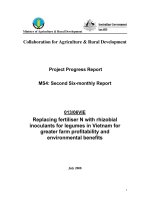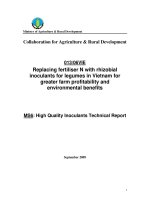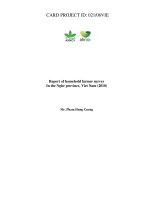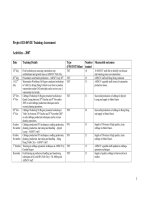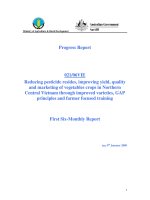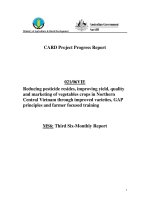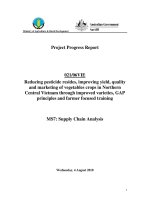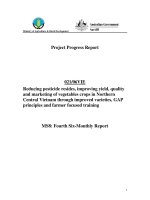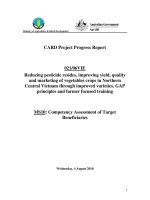Báo cáo khoa học nông nghiệp " Milestone 9 Project Validation and Impact Assessment Report - Part 1 " potx
Bạn đang xem bản rút gọn của tài liệu. Xem và tải ngay bản đầy đủ của tài liệu tại đây (197.54 KB, 54 trang )
1
Ministry of Agriculture & Rural Development
_____________________________________________________________________
Milestone 9
Project Validation and Impact Assessment Report
Part 1
Project Name
Introduction of the principles of GAP for citrus through
implementation of citrus IPM using Farmer Field Schools
Vietnamese Institution
Ministry of Agriculture and Rural Development, Plant
Protection Department
Vietnamese Project Team Leader
Mr Ngo Tien Dung
Australian Organisation
University of Western Sydney
Australian Personnel
Oleg Nicetic, Robert Spooner-Hart, Elske van de Fliert
Date commenced
March 2007
Completion date (original)
February 2010
Completion date (revised)
August 2010
Contact Officer(s)
In Australia: Team Leader
Name:
Oleg Nicetic (til 2/07/10)
Robert Spooner-Hart (from 3/07/20)
Telephone:
+61245701329
Position:
Research Associate
Fax:
+61245701103
Organisation University of Western Sydney Email: r.spooner-
In Australia: Administrative contact
Name:
Gar Jones
Telephone:
+6124736 0631
Position:
Director, Research Services
Fax:
+6124736 0905
Organisation
University of Western Sydney
Email:
In Vietnam
Name:
Mr Ngo Tien Dung
Telephone:
+84-4-5330778
Position:
National IPM coordinator
Fax:
+84-4-5330780
Organisation
Plant Protection Department
Email:
2
Introduction
Methodology for the impact assessment of project 037/06 VIE was developed in 2007 at the
project management team (Mr Ngo Tien Dung, Mr Ho Van Chien, Mr L Q Quong and Oleg
Nicetic) meeting in My Tho on 31/05/2007 and workshops held in Ha Noi on 26/09/07 and in
My Tho on 30/09/07. The workshop in Ha Noi was attended by PPD staff, staff from
Regional Plant Protection Centre 4 and trainers from Nghe An and Ha Tay provinces. The
workshop in My Tho was attended by staff from the Southern Regional Plant Protection
Centre and trainers from Tien Giang and Can Tho Provinces. Trainers that attended the
workshops were directly involved in the project impact assessment over past 2 years.
Impact assessment was done using three different methods:
a) Before and after (B&A) surveys. In each province, 5 farmers and 2 trainers were
surveyed just after commencing their participation in FFS (June 2007) and 2 years after
completion of FFS (March-May 2010).
b) Continuous monitoring of two groups of farmers. FFS group and non-FFS group in two
northern provinces (Nghe An and Ha Tay) and two provinces from Mekong delta (Tien
Giang and Can Tho). Continuous monitoring was conducted from January 2008 to December
2009 in Northern provinces and from January 2008 to June 2010 in the Mekong delta.
c) Semi-structured focus discussion groups with farmers. Focus groups were conducted
with farmers participating in 2007 and 2008/9 FFSs in 8 Northern provinces and farmers
participating in 2007 FFSs in the Mekong delta. Focus group discussion was complimented
with field visits to farmers’ orchards and assessment of their compliance with GAP
requirements, and analysis of key markets for GAP fruit.
This report only presents the findings of focus group discussions and assessment of
compliance with GAP requirements. These findings give very good insight into farmers’
perceived benefits from the project (economic, social and environmental) and a more
objective picture of practice change implemented in the orchards since focus group
discussion results were cross-checked with field observations and farmer records. Data
presented for compliance with GAP requirements are the result of discussions with farmers,
their trainers and from field inspections. Compliance was assessed against criteria outlined in
the GAP manual developed as a part of our project, which was based on GLOBALG.A.P.
For easier presentation, results from 13 provinces where activities of our project were
conducted are grouped into 3 regions: a) “Mekong Delta” comprising 5 provinces from the
Mekong delta (Ben Tre, Tien Giang, Vinh Long, Dong Thap and Can Tho), b) “Northern
Central Provinces” comprising two provinces from Northern Central Vietnam: (Ha Tinh and
Nghe An) and 2 provinces that are south of Hanoi (Hoa Binh and Ha Tay) and c) “Northern
provinces” comprising provinces north of Hanoi (Phu Tho, Yen Bai, Tuyen Quang, Ha
Giang).
3
Material and Methods
1 Focus group discussion
Focus group discussions were conducted from 24 to 27 March in Northern Provinces, from
26 to 29 April 2010 in Northern Central Vietnam and from 3 to 7 May 2010 in Mekong delta
(Table 1). In Northern provinces 2 focus group discussions were held in each province: one
focus group discussion with 5 farmers that graduated from FFSs in 2007 (1 growing season
FFSs) and other with 5 farmers that graduated from 2008/2009 FFSs (2 growing season
FFS). In Mekong delta only one focus group discussion was conducted with 5 farmers that
graduated from FFSs in 2007. Focus group discussions in Mekong delta were held in a house
of one of the farmers while in the 8 Northern provinces discussions were mainly held in
community centres.
Discussions were facilitated in Northern Provinces by Oleg Nicetic and Mr Nguyen Tuan
Loc, Vice-director of PPD Regional Centre 4 in Vinh City and by Oleg Nicetic and Mr Le
Quoc Cuong Vice-director of PPD Southern Regional Plant Protection Centre in My Tho.
On average, discussions lasted just over one hour. Facilitators made every effort to involve
all farmers present in discussions, but in most cases 1-2 farmers would take a clear lead
giving most of the opinions. Facilitators however confirm all conclusions recorded in
Appendix 1 with all participants. Farmers were only given topics (i.e. practice change,
economic, social, environmental benefits and record keeping) with no prompts or sub-
questions. Implications of this method are that we can be reasonably confident that what
farmers mentioned really did happen, but we cannot know if farmers did not mention certain
changes of practice because they didn’t see them as important or if there was no change in
practice at all. Consequently responses are recorded in Tables 2 to 13 as “yes” if farmers
mentioned changes in a specific category i.e. pruning, fertiliser use, reduction in number of
pesticide, increase in yield, reduction in inputs etc. and “not stated” if farmer did not mention
any change in that category. Exceptions are two questions that were specifically asked: a)
“Do you still keep records?” and b) “Did you introduce weaver ants?”, so answers were
recorded as “yes” or “no” in those two categories. Questions related to record keeping
recorded in Table 14 were individually asked of each farmer so the results can be expressed
as percentages of the total number of respondents.
Any claim related to practice change that could not be confirmed in the orchard or confirmed
by farmers’ or trainers’ records was not recorded in Appendix 1. Major social benefits
claimed were also checked e.g. existence of farmer clubs/cooperatives, promotion of FFS
members to community leading positions.
It was much more difficult to confirm farmers’ statements in relation to economic,
environmental and social benefits. For example a number of respondents reported significant
increases in yield and income, but it is not possible to establish what proportion of that
increased yield and income is due to changed management practices and how much is due to
yearly variation in yield and prices. For environmental impact most of the farmer reported
increase in number of beneficial organisms being present in their orchards. However, as part
of the FFS training involved identification of pests, diseases and beneficial organisms, it is
impossible to distinguish if the perceived increases were a consequence of an actual increase
in beneficial organisms, or an increased ability of respondents to recognise beneficial
organisms.
4
Table 1: Location and time of focus group discussions
Province District Village Year of
FFS
Date of
focus group
discussion
Number
of
farmers
Major crop
Mekong delta
Ben Tre Ben Tre
City
Phu
Nhuan
2007 03/05/10 5 Pomelo
Tien
Giang
Cai Be My Loi A 2007 07/05/10 5 King orange
Vinh
Long
Binh
Minh
My Hoa 2007 04/05/10 5 Pomelo
Dong
Thap
Lai Vung Long Hau 2007 06/05/10 5 Tieu
mandarin
Can Tho Phong
Dien
Nho 2007 05/05/10 5 Sweet orange
(Rambutan
now)
Northern Central Vietnam
Huong
Son
Son
Truong
2007 29/04/10 5 Orange Ha Tinh
Vu
Quang
Son Tho 2008/9 29/04/10 4 Orange
Anh Son Dinh Son 2007 28/04/10 5 Orange Nghe An
Nghia
Dan
Nghia
Son
2008/9 28/04/10 5 Orange
Hoa Binh Cao
Phong
Group 6
Cao
Phong
Company
2007 27/04/10 5 Orange
Ha Tay Phuc Tho Van Ha 2007 26/04/10 4 Pomelo and
oranges
Chuong
My
Xuan Mai 2008/9 26/04/10 4 Pomelo
Northern Vietnam
Phu Tho Doan
Hung
Que Lam 2007 24/03/10 5 Pomelo
Doan
Hung
Bang
Doan
2008/9 24/03/10 4 Pomelo
Yen Bai Yen Bai Dai Binh 2007 25/03/10 5 Pomelo
Van
Chan
Thuong
Bang La
2008/9 25/03/10 5 Orange
Tuyen
Quang
Ham Yen Tan Yen 2007 27/03/10 5 Orange
Ham Yen Yen Phu 2008/9 26/03/10 4 Orange
Ha Giang Vi
Xuyen
Viet Lam 2007 26/03/10 5 Orange
Vi
Xuyen
Trung
Thanh
2008/9 26/03/10 3 Orange
5
It may be assumed that contributing all positive economic and environmental effects
recorded in this project impact assessment solely to the farmers’ participation in FFS is likely
to result in an overestimation of the benefits of FFS and our project but it can be assumed
that while participation in FFSs does not contribute all of the benefits, it does at least partly
contribute to the reported yield income increases and profitability increases as well as in
improved environment.
2 Compliance with GAP requirements
Data presented for compliance with GAP requirements are the result of discussions with
farmers and their trainers during focus group discussions and field inspections by the impact
assessment team after discussions. In a few cases inspections were done in mid 2009.
Compliance was assessed against criteria in the GAP manual developed as a part of our
project and hence represents compliance with GLOBALG.A.P. Assessments were recorded
in a form (Appendix 2).
3 Analysis of key markets for GAP citrus fruit
Information about key markets for GAP citrus fruit was obtained from informal interviews
with the Vice-Director of My Hoa Cooperative and 5 of the farmer members. Information
was also sourced from Provincial Agriculture Department Officials and Dr Vo Mai, the Vice
President of VacVina.
6
Results and discussion
1. Change of practices
1.1 Northern Central provinces
1.1.1. FFS conducted in 2007 (1 season FFS)
Farmers participating in focus group discussions in 3 Northern Central provinces stated that
after participating in FFSs they monitor presence of pests and diseases because they are now
confident in their ability to identify them (Table 2). Farmers also understand importance of
recognising the right stage of citrus development (bud burst) for successful preventative
control of citrus leaf miner and citrus psylla. Monitoring resulted in significant reduction of
pesticide sprays used: in Hoa Binh province for example pesticide sprays were reduced from
12 sprays to 5-6 sprays. Use of PSO increased in all 3 provinces. Reduction in herbicide use
and swing towards more IPM compatible pesticide was also recorded.
Increase in use of organic fertiliser, mainly home prepared mixtures of manure and other
organic material, was recorded in all provinces. The timing of fertiliser applications changed
from once after harvest to more frequent applications mainly twice a year (4 times a year in
Ha Tay). Improvement in pruning was stated in all 3 provinces
Farmers in Nghe An province had to discontinue citrus production and start production of
grasses for cow feed to support development of dairy industry in the province so they did not
talk about practice change during focus group discussion.
1.1.2. FFS conducted in 2008/9 (2 season FFS)
Changes of practices for 2 season FFSs were similar to changes recorded for 1 season FFSs.
Farmer monitor presence of pest and diseases and they are now confident in their ability to
identify them. They also understand importance of applying pesticide at the right stage of
citrus development (bud burst) for successful preventative control of citrus leaf miner and
citrus psylla. Monitoring resulted in significant reduction of pesticide sprays used in Nghe
An province from 10-12 sprays to 6-7 sprays. In Ha Tay and Ha Tinh provinces use of
pesticide was low before the start of FFS and no reduction of pesticide use were stated by
farmers. However in both of these provinces reductions of herbicide use were stated.
Increase in use of organic fertiliser, mainly home prepared mixture of manure and other
organic material, was recorded in Ha Tinh and Ha Tay provinces and increase of foliar
fertiliser use was recorded in Nghe An province. The timing of fertiliser application changed
from once after harvest to more frequent applications mainly twice a year (4 times a year in
Ha Tay). Improvement in pruning was stated in all provinces except Ha Tinh.
Farmers in Hoa Binh province were on an excursion to visit historic sites from the liberation
war so they could not participate in the impact assessment.
7
1.2 Northern provinces
1.2.1. FFS conducted in 2007 (1 season FFS)
Farmers participating in focus group discussions in 4 Northern provinces stated that after
participating in FFSs they can recognise major pest and diseases and they practice regular
monitoring in their orchard (Table 3). They also understand the importance of applying
pesticides at the right stage of citrus development (bud burst) for successful preventative
control of citrus leaf miner and citrus psylla. Monitoring resulted in significant reduction of
pesticide sprays used in Yen Bai province from 8-10 sprays to a few (exact number not stated
by farmers) and in Tuyen Quang province from 8-10 sprays to 3-5. In Phu Tho province
farmers stated a reduction of pesticide use but they did not specify the number of sprays. In
Ha Giang the number of pesticide sprays increased from 4-5 to 6-7. Increased number of
sprays is due to increased use of miticides that resulted in significant improvement in fruit
quality. Use of PSO increased in all provinces except Yen Bai.
Increase in use of organic fertiliser, mainly manure, was recorded in all provinces except Ha
Giang. The timing of fertiliser application changed from once after harvest to twice a year
was recorded in Phu Tho and Tuyen Quang. Improvement in pruning was stated by farmers
in all provinces
1.2.2. FFS conducted in 2008/9 (2 season FFS)
Changes of practices for 2 season FFSs were similar to changes recorded for season 1 FFSs.
Farmers monitor the presence of pest and diseases and they are now confident in their ability
to identify them. They also understand the importance of recognising the right stage of citrus
development (bud burst) for successful preventative control of citrus leaf miner and citrus
psylla. Monitoring resulted in significant reduction of pesticide sprays used in Tuyen Quang
province from 8-10 sprays to 3-5 sprays. In Yen Bai province farmers significantly reduced
pesticide use, not by reducing the number of sprays but by discontinuing the practice of
mixing many pesticides together. In Phu Tho province reduction of pesticide use was not
stated but it was low and it remains low. Similar to 2007, the FFS in Ha Giang increased use
of pesticide. Before the FFS, farmers used no or very few pesticide sprays.
Increase in use of manure was recorded in Tuyen Quang and Ha Giang provinces and
increase in foliar fertiliser use was recorded in all provinces except Tuyen Quang. The
method of application of fertilizers changed from once after harvest to twice a year (3 times
per year in Yen Bai). Improvement in pruning was stated in all provinces.
1.3. Mekong delta
Farmers participating in focus group discussions in all 5 provinces from Mekong delta stated
that after participating in FFSs they are now confident in identification of major pests and
diseases (Table 4). Before they apply pesticide they monitor for presence of pests and
diseases or the right stage of citrus development (bud burst for preventative control of citrus
leaf miner and citrus psylla). This resulted in significant reduction of pesticide sprays used.
In Dong Tap province, which had the highest use of pesticides, the number of sprays was
reduced from over 30 to 15-20. In Tien Giang province sprays were reduced from over 15 to
8-12. In Ben Tre province the interviewed farmers practically stopped using broad spectrum
pesticides and pests and diseases were managed with PSO, Trichoderma and weaver ants.
8
Use of compost was recorded in all provinces, while the method of application of fertilizers
changed in Ben Tre and Tien Giang to include more frequent applications at a lower dose.
Improvement in pruning was stated in all provinces except Vinh Long. In Can Tho province
farmers were found to have very poor orange orchards with little earning potential in the
2007 baseline study. After the FFS farmers introduced cultivation of rambutan and only one
out of the 5 farmers was still growing oranges. The newly established rambutan orchards had
their first harvest and provided good return.
2. Economic impact
2.1 Northern Central provinces
2.1.1. FFS conducted in 2007 (1 season FFS)
In Ha Tinh and Ha Tay farmers stated increase in yield and quality of fruit (Table 5). In Ha
Tinh farmers also stated increase in price of their products. In Nghe An and Hoa Binh
farmers stated increase in profitability of their production. In Hoa Binh farmers claimed
increase in income from 20-30,000,000 VND before FFS to 70,000,000 after FFS.
2.1.2. FFS conducted in 2008/9 (2 season FFS)
In Ha Tinh farmers stated an increase in yield. In Nghe An and Ha Tay farmers stated
increase in profitability of their production. In Nghe An farmers claimed increase in income
from 20-30,000,000 VND before FFS to 50,000,000 after FFS.
Farmers from Hoa Binh did not participate in focus group discussions.
2.2 Northern provinces
2.2.1. FFS conducted in 2007 (1 season FFS)
In Phu Tho and Yen Bai farmers stated reduction in input costs (Table 6). In Tuyen Quang
farmers stated reduction in input costs and increase in profitability of their production and in
Ha Giang farmers stated increased quality of fruit and increase in profitability.
2.1.2. FFS conducted in 2008/9 (2 season FFS)
In Phu Tho farmers stated reduction in input costs. In Yen Bai and Tuyen Quang farmers
stated improvement in all categories: reduction in input costs, increased yield, increased
quality of fruits and higher profitability of production. In Ha Giang farmers stated increased
yield and quality of fruits.
2.3. Mekong delta
In Ben Tre and Vinh Long farmers stated improvement in all categories: reduction in input
costs, slight increase in yield, increased quality of fruits and higher profitability of production
(Table 7). In Tien Giang and Dong Thap farmers stated a reduction of input costs, increased
quality of fruit and higher profitability. In Can Tho farmers introduced production of
rambutan, resulting in significant increase in profitability in comparison to previously grown
oranges.
9
3. Social impacts
3.1 Northern Central provinces
3.1.1. FFS conducted in 2007 (1 season FFS)
In Ha Tinh and Hoa Binh farmers stated increase in sharing of knowledge and experiences,
and increase in social activities and better relationships in the community as result of FFSs.
They also claimed increase in their confidence and self-esteem (Table 8). In Nghe An
farmers stated increase in sharing of knowledge and experiences, and increase in social
activities and better relationships in community. In Ha Tay, participants of FFS claimed
improved social standing in their community.
3.1.2. FFS conducted in 2008/9 (2 season FFS)
In Ha Tinh farmers stated an increase in sharing of knowledge and experiences with other
community members and increase in their standing in the community. In Nghe An,
participants of FFS claimed improved social standing. In Ha Tay farmers stated an increase
in sharing of knowledge and experiences, and increase in social activities and better
relationships in the community as result of FFSs. They also claimed increase in their
confidence and self-esteem as well as improved social standing in their community.
3.2 Northern provinces
3.2.1. FFS conducted in 2007 (1 season FFS)
In Phu Tho farmers stated an increase in sharing of knowledge and experiences with other
community members, increase in social activities and increase in their standing in the
community (Table 9). In Yen Bai and Tuyen Quang farmers stated an increase in shearing of
knowledge and experiences with other community members, increase in social activities and
better relationship in community. These resulted in formation of farmers’ club in Tuyen
Quang province and farmers’ plan to brand their oranges. In Ha Giang farmers stated an
increase sharing of knowledge and experiences and increase of their standing in the
community. One participant in the FFS became the hamlet leader.
3.2.2. FFS conducted in 2008/9 (2 season FFS)
In Phu Tho farmers stated an increase in sharing of knowledge and experiences with other
community members, increase in social activities and increase in their standing in the
community In Yen Bai farmers stated an increase in sharing of knowledge and experiences
with other community members. They also increased their self-esteem and confidence
resulting in their higher standing in the community. Farmers formed a club and looking at
possibilities of forming a cooperative. In Ha Giang farmers stated an increase in sharing of
knowledge and experiences, and increase in social activities and better relationships in the
community as result of FFSs. They also claimed increase in their confidence and self-esteem
as well as improved social standing in their community.
10
3.3. Mekong delta
In all 5 provinces in the Mekong delta farmers claimed an increase in sharing of knowledge
and experiences, and increase in social activities and better relationships in the community as
result of FFSs. They also claimed increase in their confidence and self-esteem. In all
provinces, except Vinh Long, FFS participants stated an improvement in their social standing
in the community. In Ben Tre and Tien Giang provinces FFS instigated formation of social
clubs and in Vinh Long province FFS increased activities in the existing cooperative. In Ben
Tre the farmers’ club will buy a computer that will be used to access agricultural extension
material.
4. Environmental impacts
4.1 Northern Central provinces
4.1.1. FFS conducted in 2007 (1 season FFS)
In all provinces farmers reported increase in the number of beneficial arthropods in their
orchards (Table 11). In Ha Tinh and Hoa Binh farmers also introduced weaver ants. In Hoa
Binh farmers claimed an increase in the number of birds.
4.1.2. FFS conducted in 2008/9 (2 season FFS)
In all provinces farmers reported increase in the number of beneficial arthropods in orchards.
In Ha Tinh farmers also introduced weaver ants. In Nghe An and Ha Tay provinces farmers
collect and burn pesticide packaging resulting in reduced pollution in orchards.
4.2 Northern provinces
4.2.1. FFS conducted in 2007 (1 season FFS)
In all provinces except Ha Giang farmers reported increase in numbers of beneficial
arthropods in their orchards (Table 12). There were no other environmental benefits stated
and there were no introductions of weaver ants.
4.2.2. FFS conducted in 2008/9 (2 season FFS)
In all provinces farmers reported increase in numbers of beneficial arthropods in their
orchards (Table 12). Weaver ants are present in orchards in Tuyen Quang and Ha Giang but
farmers did not introduce them or encouraging their development. Before FFS in Ha Giang
farmer used to kill weaver ants because they regarded them as pests. There were no other
environmental benefits stated.
3.3. Mekong delta
In all provinces farmers reported increase in numbers of beneficial arthropods in their
orchards (Table 13). Weaver ants were introduced in all orchards. Farmers from all provinces
except from Dong Thap claimed increase in abundance of fish in canals. In Ben Tre, Tien
Giang and Vinh Long provinces farmers collect and burn pesticide packaging resulting in
reduced pollution in orchards. In Tien Giang and Dong Thap farmers reported improvement
11
in their own health as result of the reduced number of pesticide sprays and changing from
more toxic to IPM-compatible pesticides.
5. On-farm record keeping system
The on-farm record keeping system was developed based on VietGAP requirements and
consists of a very simple and cheap record book that was evaluated by farmers in the first
year of FFSs. The record keeping books are now used by farmers several years after the
completion of FFSs. In some provinces, extension services have reprinted the book and
distributed them to farmers. In focus group discussions in all 13 provinces the acceptance of
record keeping was overwhelming with 97% of farmers finding record keeping useful and
91% of farmers will continue to keep records. Farmers recognised the following advantages
of record keeping: awareness of input costs (53% of respondents), awareness of labour costs
(33%), awareness of income from fruit sale (44%), awareness of production profitability
(85%), awareness of fertilisers used so the farmer can assess their effectiveness (30%),
records help farmers to predict pest occurrence (33%), awareness of pesticides used enables
farmers to assess their effectiveness (49%). Another advantage of using records mentioned
by several farmers was selection of a cheaper pesticide shop (based on prices recorded
farmers who became aware of differences in prices between shops). Detailed findings from
the interviews are presented in Table 14.
6. Compliance with GAP requirements
There is virtually no compliance with GLOBALG.A.P. or even VietGAP requirements in any
of the participating provinces. However, after completion of our project farmers that
graduated from FFSs in most provinces now comply in the area of plant protection, fertiliser
use and record keeping. For the purposes of this survey, farmers who complied with some
components of the GAP requirements within each of the 12 major categories of GAP were
considered to “partly comply”. Although “partial compliance” is not an official category in
GAP certification, it was used as an indicator of the GAP categories within which farmers
can reach compliance without major changes to their present practices. For example, most of
the farmers use some kind of protective clothing so we recorded “partly comply” (PC) for the
“Workers health” category. Following are the results presented separately for each of 3
regions.
6.1 Northern Central provinces
Results show non-compliance to be highest for product traceability and site history (Table
15). In Vietnam, it is very difficult to find records for site history and there are no post-
harvest management facilities for of citrus that would provide post-harvest treatment of fruits
such as washing, waxing and packaging. For that reason in category “post-harvest” we
recorded “not applicable” (N/A) even though that could be also considered as non
compliance. Luck of packaging facilities makes traceability very difficult. Fruit are collected
from the farmers by ‘middle men’ or in some cases the farmer sells directly to consumers at
the farm or a nearby market so traceability is not possible.
There are not enough certified planting materials on the market and farmers traditionally use
marcotting for production of plant material, so in Ha Tinh and Nghe An there was no
compliance in “variety and rootstock category” but in Hoa Binh (a former state farm that
leased land to farmers) and Ha Tay (small scale pomelo production) farmers used certified
planting material.
12
Crop protection is marked as PC even though most of the farmers practice IPM after FFSs,
but they do not comply with requirement of using only pesticides registered for citrus.
Farmers are aware of the need to use registered products and to comply with the withholding
period. However farmers and PPSD staff do not have a full understanding of the GAP
requirement for a registered product. The GAP requirement for a registered pesticide is that
the pesticide is specifically registered for the targeted crop (citrus in our case), while PPD
staff described a registered product as a pesticide registered for any crop in Vietnam that has
not been placed on the list of banned pesticides. Consequently, if no specific pre-harvest
interval was set for citrus (because the product was not registered for citrus) then no
compliance with this requirement is possible. It is generally accepted that a 14 day pre-
harvest withholding period is acceptable for any pesticide.
Compliance requirements for record keeping and fertiliser use have been met by most of
interviewed farmers so that categories were marked as complied (C) for all 4 provinces.
Environmental issues such as the requirement for field toilets can be only solved with the
help of local governments. Farmers generally do not store pesticides on site and that reduces
environmental risks.
Overall only farmers from Hoa Binh showed interest in GAP certification but no action
towards achieving the certification was taken during the project timeframe.
6.2 Northern provinces
Compliance with GAP requirements in Northern provinces is very similar to compliance in
the Northern Central provinces (6.1) with lower compliance in use of certified planting
material (Table 15).
Only in two cases, one in Yen Bai and another in Tuyen Quang, did farmers form clubs and
show some interest in GAP certification but it is unlikely that any of these two clubs will
apply for certification in the foreseeable future.
6.3 Mekong delta
Even though production in Mekong delta is at the higher level than in Northern Vietnam and
farmers’ income is considerably higher, the compliance with GAP requirements is on a
similar level to that for the North (Table 16). However, interest in GAP certification is much
higher than in the North, farmers are much better organised (many farmers’ clubs and
cooperatives have been formed) and there is higher level of support from local governments.
In addition, because they have more profitable production they have more money to invest in
the post-harvest facilities necessary for GAP certification.
With regard to meeting GAP requirements in the Mekong delta the additional problem is
irrigation and the requirement for clean water. In the crop protection category, in addition to
using pesticide not specifically registered for citrus, another difficulty is meeting pre-harvest
interval requirements, because continuous flowering and fruiting throughout the year results
in continuous harvesting. Compliance in variety and rootstock category is very low but that
will eventually change with more certified material becoming available.
It is interesting to note that farmers from My Hoa cooperative,l even though they received
GLOBALG.A.P. certification in 2008, did not comply with all GAP requirements during our
inspection.
Overall, the citrus industry in Vietnam is far from meeting GLOBALG.A.P. requirements.
There are many infrastructure changes (e.g. sewage system and construction of packaging
warehouses) that need to be made before compliance with GLOBALG.A.P. will be possible.
13
Also, improvements in the pesticide registration system need to be made so that appropriate
pesticides are registered for citrus. It appears that the difference between practices used in the
Vietnamese citrus industry and those required by GLOBALG.A.P. is too great for
GLOBALG.A.P. to be considered as a realistic model for widespread implementation of
GAP in Vietnamese citrus. Unfortunately, VietGAP does not differ too much from
GLOBALG.A.P. and still contains many requirements that will be very difficult to
implement within current Vietnamese socio-economic realities. However, VietGAP is still a
better option for a Vietnamese citrus industry mainly concentrated on domestic marketing.
The implementation of GLOBALG.A.P. is only suitable for a limited number of cooperatives
targeting export markets.
4.3 Analysis of key markets for GAP citrus fruit
The value of citrus in the Vietnamese domestic market is very high and there are no
incentives for Vietnamese farmers to concentrate on export. For oranges, farmers can get at
the farm gate between 2 and 12,000 VND per kilogram, for mandarins the price can go over
20,000 VND per kilogram and for pomelo from 3-7,000 per kg for Nam Roi variety in the
Mekong delta and up to 20,000 VND per kg for Dien variety in the Northern provinces.
However, yields of Nam Roi per unit area is much higher so returns to farmers from Nam
Roi, on average, is higher than for Dien. The export price for Nam Roi pomelo is US1-1.6
FCO Hai Phong, which indicates that farmers do not obtain a premium price for the exported
product.
The income Vietnamese farmers obtain from citrus on the domestic market is good, not just
in comparison to citrus world market but also in comparison to other crops farmers can grow
on their land. A comparison between the income from rice and citrus shows that net returns
from citrus are 3 - 6 times higher (Table 19). In the Mekong delta, the price of pomelo and
mandarin is stable but the price of oranges in the Northern provinces fluctuates more because
of the high fluctuation in yields from year to year that is a characteristic of oranges. Farmers
do not know how to reduce the number of overloaded fruits in high production years to
escape the price plunge and to regulate flower bud initiation for next year’s crop. For
example, in Tuyen Quang province in 2008 the yield was between 25-40 kg/tree and the
price for kg of oranges was about VND 2,000; whereas, in 2009 the yield was only 5-10 kg
per tree and price was about VND 10,000/kg.
Marketing of citrus fruit in all provinces is mainly through a ‘middle man’, who comes and
buys fruits at the farm. A very small percentage of the fruit is sold by the farmers in markets
in their local towns, and farmers do not directly sell fruit at the markets of the major centres
(e.g. Hanoi, HCMC). Only in one FFS (Vinh Long province) are farmers directly connected
with the supermarket (Metro) and a few FFSs have being conducted in cooperatives that have
their own cooperative retail outlets (Vinh Long province). None of the fruit produced by
farmers participating in FFS undergo any post-harvest processing. There are no packing
houses in any of provinces that are involved in the project. This lack of post-harvest facilities
is the major reason why it is unlikely that, after completion of our project, there will be
widespread introduction of GAP that will have an impact on export of Vietnamese citrus.
The main outcome of our project in regard to GAP implementation is development of
resources for GAP implementation: GAP manual, reference material for farmers and trainers
(books and brochures) and on-farm record keeping system. Project also developed a
14
significant pool of trained farmer that will be able to implement GAP and gain GAP
certification, if market requirements for the GAP-certified citrus fruit grows and farmers can
get a premium price by accessing the upper end of the domestic market (supermarkets, hotels
and restaurants).
However, at present it seems that there are few economic benefits for GAP-certified
producers. Farmers from My Hoa cooperative stated during focus group discussion that they
are now selling fruits outside the cooperative on the market because they can get a higher
price. In an interview held with the cooperative’s vice-director in February 2009, we were
told that even though Metro provided substantial funds to be used for GLOBALG.A.P.
certification the supermarket chain did not commit to buy fruit from the cooperative. Funds
were used to hire consultants to provide additional one-to-one training and to help farmers
keep the required records, to subsidise costs of building the infrastructure necessary for
compliance with GAP including pesticide storage facilities and field toilets and the remainder
of the funds were used for the certification process itself. According to the interviewed vice-
director and a few farmer-members of My Hoa cooperative, after the certification process
was completed and the consultants’ support was terminated, the farmers had problems with
record keeping on their own, and neither the cooperative nor the farmer-members had any
significant increase in income as result of GAP certification. We also talked with a
representative of the exporter to the Netherlands and she said that GAP is not required for
export and that the Dutch importers perform their own quality control checks, including
pesticide residue assessment, so GAP certification did not increase the price paid for
exported pomelo.
It seems that the most beneficial aspect of GAP certification for My Hoa cooperative has
been the positive media coverage, since the cooperative is the first and only citrus producer
that received GAP certification. However, the vice-director of My Hoa Cooperative
expressed doubt that the certification will be renewed after it expires. However, that does not
mean that the implementation processes and good production practises introduced by
cooperative will not continue.
15
Table 2: Change in agricultural practices identified in focus group discussions with farmers Northern Central Provinces (Summary)
Practice change stated by farmers during focus group discussions
Province
ye
ar
Can now
identify
pests &
diseases
Monitor
pests &
diseases
Record
keeping
Number
of sprays
reduced
Pesticide type change Fertiliser
application
time changed
Fertilizer type changed
(increased use or
introduced)
Weaver
ants
1
Pruning
(improved
or
introduced)
Other
07
Yes Yes Yes Yes PSO 1x to 2x Manure Yes Yes
Reduced number of
trees per area
Ha Tinh
08/
09
Yes Yes Yes
Not
stated
PSO
Neonicotinoids
Herbicide not
used after FFS
1x to 2x
Organic fertiliser
prepared at home
Yes
Not
stated
07
n/a n/a n/a n/a n/a n/a n/a n/a n/a n/a
Nghe An
08/
09
Yes Yes Yes
Yes,
10-12
to 6-7
PSO 1x to 2x Foliar fertiliser No Yes
07
Yes Yes Yes
Yes,
12 to
5-6
PSO
abamectin
Yes
Organic fertiliser
Urea (Decrease )
Yes Yes
Hoa Binh
08/
09
n/a n/a n/a n/a n/a n/a n/a n/a n/a n/a
07
Yes Yes Yes Yes
PSO
abamectine
1x to 4x Organic fertiliser No Yes
Ha Tay
08/
09
Yes Yes Yes
Not
stated
Reduced
herbicide use
Baits for fruit fly
1x to 4x
Organic fertiliser
prepared at home
No Yes
1
Participants were specifically asked if they introduced weaver ants so for this indicator it is possible to have negative answer.
16
Table 3: Change in agricultural practices identified in focus group discussions with farmers Northern Provinces (Summary)
Practice change stated by farmers during focus group discussions
Province
ye
ar
Can now
identify
pests &
diseases
Monitor
pests &
diseases
Record
keeping
Number
of sprays
reduced
Pesticide type change
Fertiliser
application
time changed
Fertilizer type changed
(increased use or
introduced)
Weaver
ants
1
Pruning
(improved
or
introduced)
Other
07
Yes Yes Yes Yes
PSO
abamectin
1x to 2x
Organic fertiliser
Foliar fertiliser
No Yes
Phu Tho
08/
09
Yes Yes Yes
Not
stated
Not stated 1x to 2x Foliar fertiliser No Yes
07
Yes Yes Yes
From
8-10
to few
Not stated
Not stated Manure
No Yes
Yen Bai
08/
09
Yes Yes Yes Yes
PSO
From mixing lot of
pesticide to
targeted
applications
1x to 3x Foliar fertiliser (3x) Yes Yes
07
Yes Yes Yes
From
8-10
to 3-5
PSO 1x to 2x Manure No Yes
Tuyen
Quang
08/
09
Yes Yes Yes
From
8-10
to 3-5
Claim to use IPM
compatible
pesticide
1x to 2x Manure No Yes
07
Yes Yes Yes
From
4-5
to 6-7
PSO Not stated Not stated No Yes
Ha Giang
08/
09
Yes Yes Yes
From
fewto
5-6
Claim to use IPM
compatible
pesticide
1x to 2x
Manure
Foliar fertiliser
No Yes
Naturally occurring
weaver ants protected
1
Participants were specifically asked if they introduced weaver ants so for this indicator it is possible to have negative answer.
17
Table 4: Change in agricultural practices identified in focus group discussions with farmers Mekong delta (Summary)
Practice change stated by farmers during focus group discussions
Province
ye
ar
Can now
identify
pests &
diseases
Monitor
pests &
diseases
Record
keeping
Number of
sprays
reduced
Pesticide type change
Fertiliser
application
time changed
Fertilizer type changed
(increased use or
introduced)
Weaver
ants
1
Pruning
(improved
or
introduced)
Other
Ben Tre 07
Yes Yes Yes
Farmers
apply very
few sprays
PSO
Trichoderma sp.
More often
3-4 x
Compost 1-2X Yes Yes
Tien Giang 07
Yes Yes Yes
From 15+
to 8-12
Trichoderma sp
PSO
More often
6x
Compost 2X
Foliar fertilisers 2-5X
Yes Yes
Vinh Long 07
Yes Yes Yes
From many
to few
Trichoderma sp
PSO
More miticides
less insecticides
Not stated Compost Yes
Not
stated
Dong Thap 07
Yes Yes Yes
From 30-35
to 15-20
Trichoderma sp
PSO
More miticides
Not stated Compost Yes Yes
Can Tho 07
Yes Yes Yes n/a n/a n/a Compost Yes Yes
Farmer grow
rambutan now
1
Participants were specifically asked if they introduced weaver ants so for this indicator it is possible to have negative answer.
18
Table 5: Economic impacts identified in interviews with farmers Northern Central Provinces (Summary)
Economic impacts stated by farmers during focus group discussions
Province
ye
ar
Decreased input
cost
Increased
yield
Increased quality of
fruit
Higher
profitability
Other
07
Not stated Yes Yes Not stated Higher price of fruit
Ha Tinh
08/
09
Not stated Yes Not stated Not stated
07
Not stated Not stated Not stated Yes
Nghe An
08/
09
Not stated Not stated Not stated Yes
Increase from VND
20-30 mil to 50 mil
07
Not stated Not stated Not stated Yes
Increase from VND
20-30 mil to 70 mil
Hoa Binh
08/
09
n/a n/a n/a n/a n/a
07
Not stated Yes Yes Not stated
Ha Tay
08/
09
Not stated Not stated Not stated Yes
19
Table 6: Economic impacts identified in interviews with farmers Northern Provinces (Summary)
Economic impacts stated by farmers during focus group discussions
Province
ye
ar
Decreased input
cost
Increased
yield
Increased quality of
fruit
Higher
profitability
Other
07
Yes Not stated Not stated Not stated
Fruit drop after
flowering. Very low
yield.
Phu Tho
08/
09
Yes Not stated Not stated Not stated
Fruit drop after
flowering. Very low
yield.
07
Yes Not stated Not stated Not stated
Fruit drop after
flowering but in lesser
extent than in Phu Tho
Yen Bai
08/
09
Yes Yes Yes Yes
07
Yes Not stated Not stated Yes
Income VND 10 mil
per 100 trees
Tuyen
Quang
08/
09
Yes Yes Yes Yes
07
Not stated Not stated Yes Yes
Income VND 15 mil
per 100 trees
Ha Giang
08/
09
Not stated Yes Yes Not stated
20
Table 7: Economic impacts identified in interviews with farmers Mekong delta (Summary)
Economic impacts stated by farmers during focus group discussions
Province
ye
ar
Decreased input
cost
Increased
yield
Increased quality of
fruit
Higher
profitability
Other
Ben Tre 07
Yes
Yes
(slight)
Yes Yes
Tien Giang 07
Yes Not stated Yes Yes
Vinh Long 07
Yes
Yes
(slight)
Yes Yes
Dong Thap 07
Yes Not stated Yes Yes
Can Tho 07
Not stated Not stated Not stated Yes
Rambutan production
21
Table 8: Social impacts identified in interviews with farmers Northern Central Provinces (Summary)
Social impacts stated by farmers during focus group discussions
Province
ye
ar
Increased shearing
of knowledge &
experiences
Increase social
activities/impro
ved relationship
in community
Increased social
standing of
FFS participants in
community
Increased self-esteem
and confidents in own
abilities
Instigate formation of
farmer club / cooperative
or increase activities in
existing
1
Other
07
Yes Yes Not stated Yes No
Ha Tinh
08/
09
Yes Not stated Yes Not stated No
07
Yes Yes Not stated Not stated
No
Nghe An
08/
09
Not stated Not stated Yes Not stated No
07
Yes Yes Not stated Yes No
Hoa Binh
08/
09
n/a n/a n/a n/a n/a
07
Not stated Not stated Yes Not stated No
Two participants of
FFS became hamlet
leaders.
Ha Tay
08/
09
Yes Yes Yes Yes No
1
Participants were specifically asked question about farmers club and cooperatives so for this indicator it is possible to have negative answer.
22
Table 9: Social impacts identified in interviews with farmers Northern Provinces (Summary)
Social impacts stated by farmers during focus group discussions
Province
ye
ar
Increased shearing
of knowledge &
experiences
Increase social
activities/impro
ved relationship
in community
Increased social
standing of
FFS participants in
community
Increased self-esteem
and confidents in own
abilities
Instigate formation of
farmer club / cooperative
or increase activities in
existing
1
Other
07
Yes Yes Yes Not stated No
One FFS participant
became president of
Farmers’ Union in
village
Phu Tho
08/
09
Yes Yes Yes Not stated No
07
Yes Yes Not stated Not stated
No
Yen Bai
08/
09
Yes Not stated Yes Yes Yes
07
Yes Yes Not stated Not stated Yes Branding
Tuyen
Quang
08/
09
Yes Not stated Yes Not stated No
07
Yes Not stated Yes Not stated No
One participant of FFS
became hamlet
leaders.
Ha Giang
08/
09
Yes Yes Yes Yes No
1
Participants were specifically asked question about farmers club and cooperatives so for this indicator it is possible to have negative answer.
23
Table 10: Social impacts identified in interviews with farmers Mekong delta (Summary)
Social impacts stated by farmers during focus group discussions
Province
ye
ar
Increased shearing
of knowledge &
experiences
Increase social
activities/impro
ved relationship
in community
Increased social
standing of
FFS participants in
community
Increased self-esteem
and confidents in own
abilities
Instigate formation of
farmer club / cooperative
or increase activities in
existing
1
Other
Ben Tre 07
Yes Yes Yes Yes Yes
Buy computer
collectively
Tien Giang 07
Yes Yes Yes Yes
Yes
Vinh Long 07
Yes Yes Not stated Yes Yes
GLOBALG.A.P.
certified
Continued relationship
with Can Tho
University
Dong Thap 07
Yes Yes Yes Yes No
Can Tho 07
Yes Yes Yes Yes No
Continued relationship
with PPSD
1
Participants were specifically asked question about farmers club and cooperatives so for this indicator it is possible to have negative answer.
24
Table 11: Environmental impacts identified in interviews with farmers Northern Central Provinces (Summary)
Environmental impacts stated by farmers during focus group discussions
Province
ye
ar
Increased number
of beneficial
arthropods in
orchards (general)
Specific
beneficial
arthropods
Weaver ants
introduced
1
Reduced pollution
from pesticide and
fertiliser packaging
Improved farmers’ health Other
07
Yes
Praying mantis
Spiders
Yes Not stated Not stated
Ha Tinh
08/
09
Yes
Praying mantis
Predatory bugs
Yes Not stated Not stated
07
n/a Not stated n/a n/a n/a
Nghe An
08/
09
Yes Not stated No Yes Not stated
07
Yes Not stated Yes Not stated Not stated
Increased number of birds
Hoa Binh
08/
09
n/a
Not stated
n/a n/a n/a
07
Yes
Leady beetles
Dragon flies
Praying mantis
Spiders
No Not stated Not stated
Ha Tay
08/
09
Yes Not stated No Yes Not stated
1
Participants were specifically asked if they introduced weaver ants so for this indicator it is possible to have negative answer.
25
Table 12: Environmental impacts identified in interviews with farmers Northern Provinces (Summary)
Environmental impacts stated by farmers during focus group discussions
Province
ye
ar
Increased number
of beneficial
arthropods in
orchards (general)
Specific
beneficial
arthropods
Weaver ants
introduced
1
Reduced pollution
from pesticide and
fertiliser packaging
Improved farmers’ health Other
07
Yes Not stated No Not stated Not stated
Phu Tho
08/
09
Yes Not stated Not stated Not stated Not stated
07
n/a Not stated n/a n/a n/a
Yen Bai
08/
09
Yes Not stated Yes Not stated Not stated
07
Yes Not stated No Not stated Not stated
Tuyen
Quang
08/
09
Yes
Weaver ants
No
Not stated Not stated
Weaver ants sighted
but not reared
07
Not stated Not stated Not stated Not stated Not stated
Ha Giang
08/
09
Yes Weaver ants No Not stated Not stated
Weaver ants were considered
pests before FFS but now they
are acknowledged as beneficial.
1
Participants were specifically asked if they introduced weaver ants so for this indicator it is possible to have negative answer.
